Abstract
BACKGROUND: To date, very few studies have evaluated the risk of infection among spouses of Helicobacter pylori positive patients and their results are conflicting. AIM: To assess the seroprevalence of H pylori infection in spouse of H pylori positive patients with duodenal ulcer as compared with age and sex matched volunteer blood donors, as well as the frequency of endoscopic gastroduodenal lesions in these spouses, according to the presence or absence of gastrointestinal complaints. METHODS: Some 124 spouses (48% males) of patients with duodenal ulcer consecutively seen over a 10 month period were studied. They were all screened for serum IgG anti-H pylori antibodies and asked to complete a questionnaire with particular reference to the presence of chronic or recurrent dyspepsia. Upper gastrointestinal tract endoscopy with antral and corpus biopsy specimens taken for histological examination and urease rapid test was offered to all seropositive spouses. Volunteer blood donors (248), living in Milan and matched for age, sex, north-south origins, and socioeconomic status to the cases, were used as controls. RESULTS: Spouses of patients with duodenal ulcer had a significantly higher seroprevalence of H pylori infection than controls (71% v 58%, p < 0.05); 30 of 88 (34%) H pylori positive spouses complained of dyspeptic symptoms compared with only four of 34 (12%) seronegative spouses (p < 0.02). At endoscopy, H pylori infection was confirmed in 48 of 49 (98%) seropositive spouses. The endoscopic findings in those spouses showed active duodenal ulcer in eight (17%), duodenal scar and cap deformity in two (4%), active gastric ulcer in two (4%), erosive duodenitis in three (6%), antral erosions in two (4%), antral erosions plus duodenitis in one, and peptic oesophagitis in another patient. The prevalence of major endoscopic lesions was significantly higher in symptomatic spouses than in those who had never been symptomatic. CONCLUSIONS: These findings show that being the spouse of an H pylori positive patient with duodenal ulcer may increase the risk of H pylori colonisation and perhaps of peptic ulcer disease, and raises questions as to whether serological screening of cohabiting partners of H pylori positive patients with duodenal ulcer may be indicated.
Full text
PDF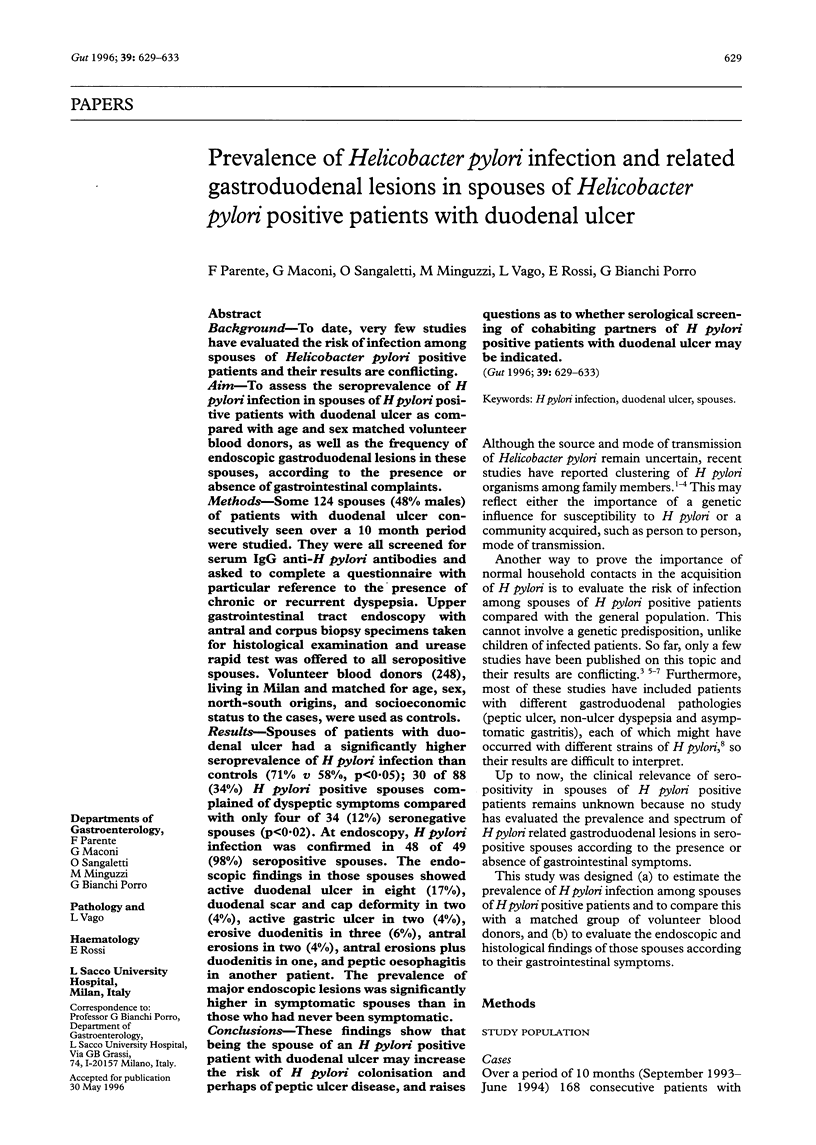
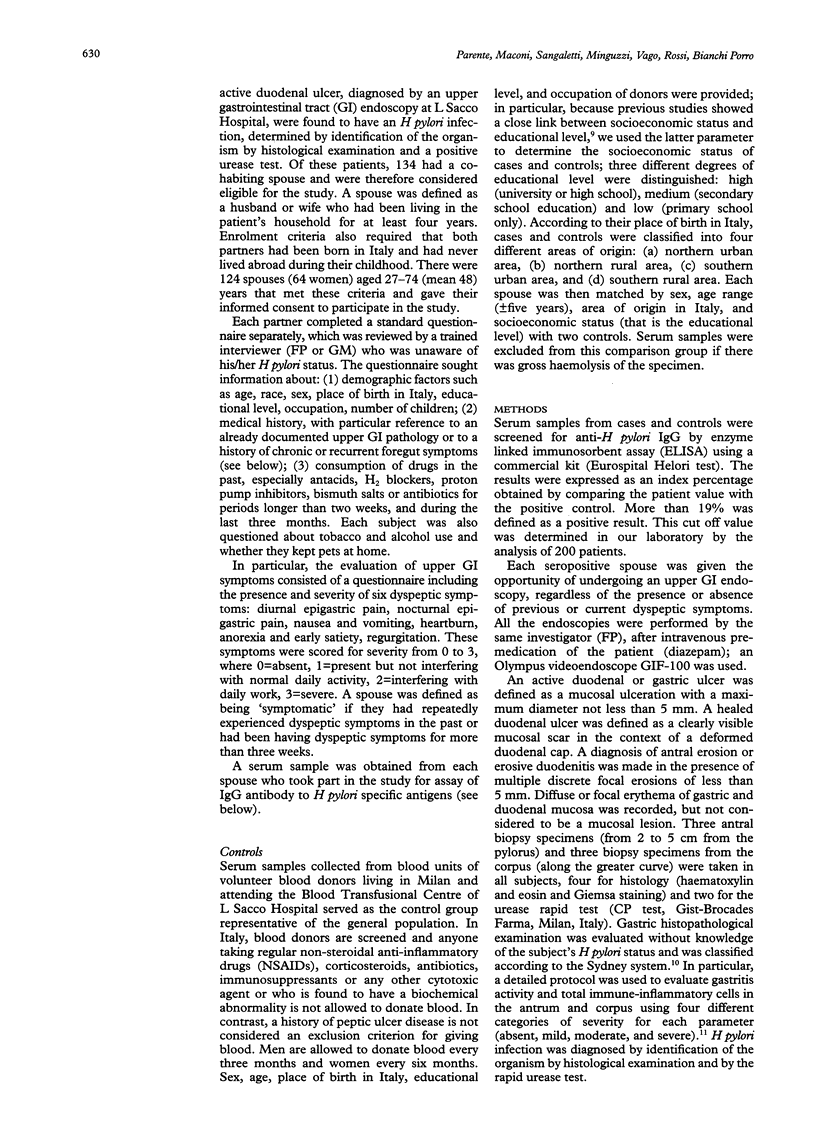
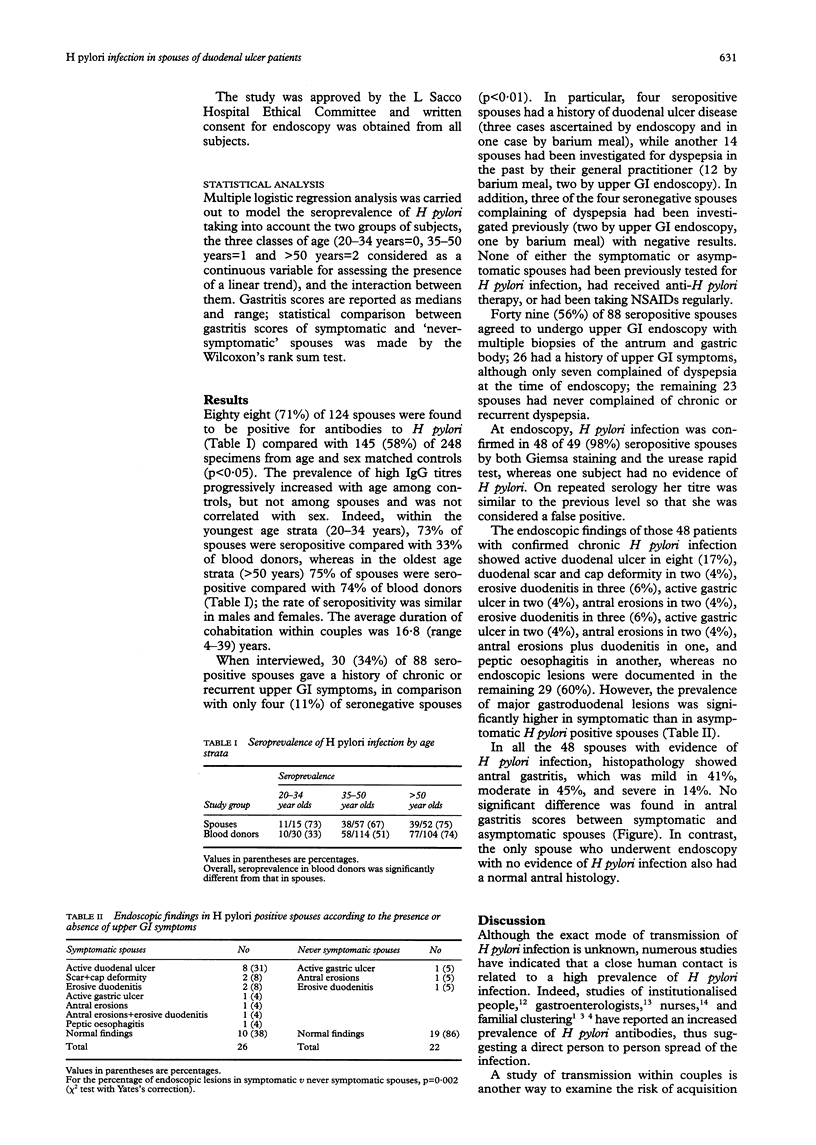
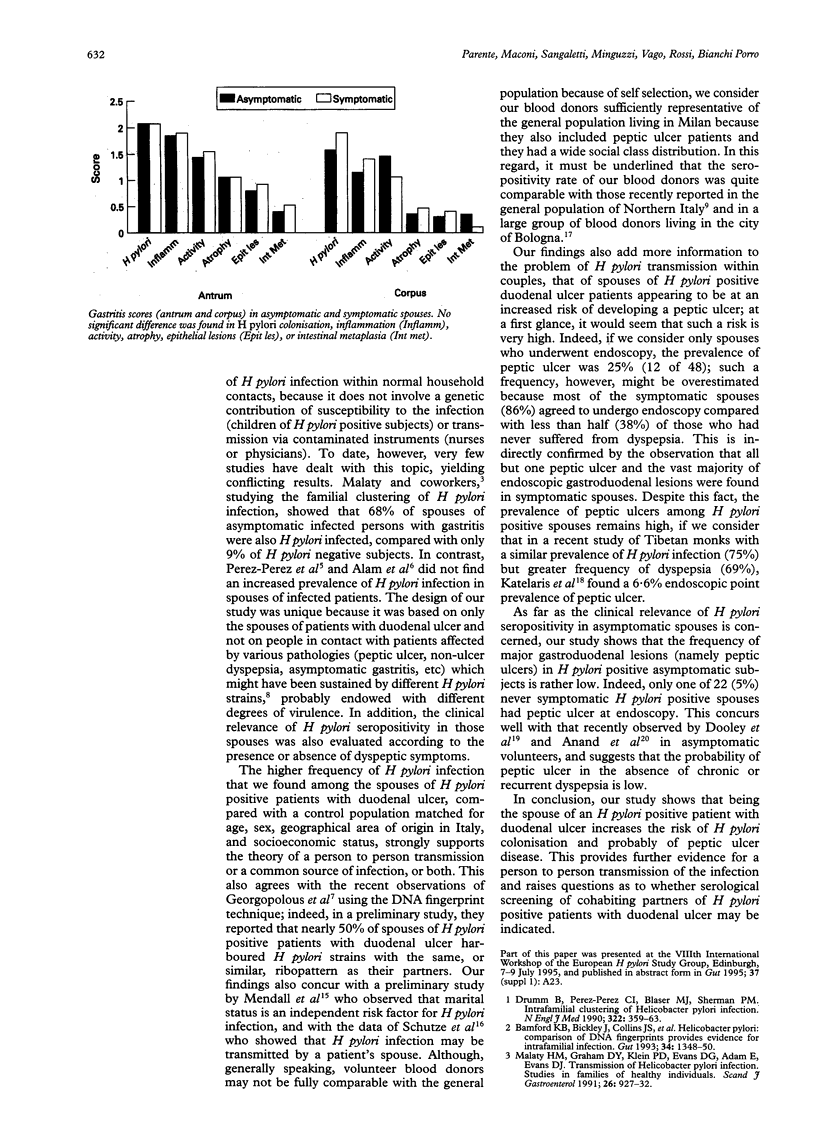
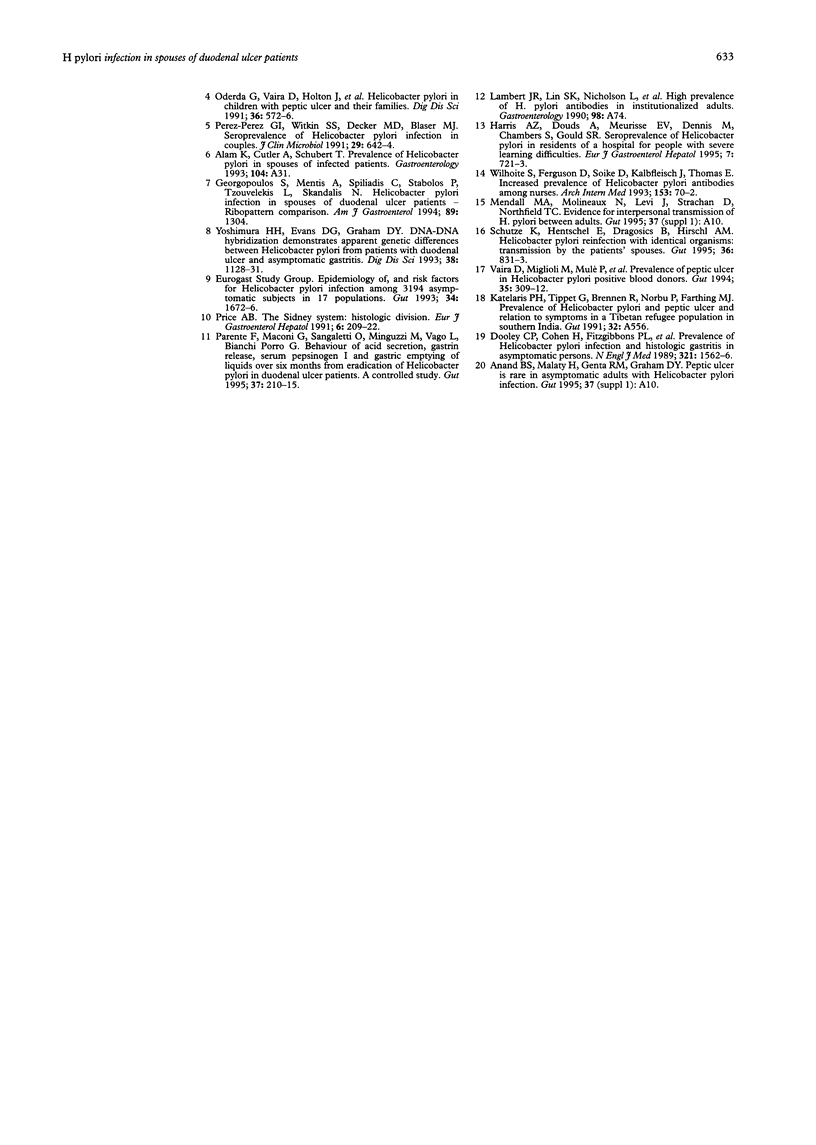
Selected References
These references are in PubMed. This may not be the complete list of references from this article.
- Bamford K. B., Bickley J., Collins J. S., Johnston B. T., Potts S., Boston V., Owen R. J., Sloan J. M. Helicobacter pylori: comparison of DNA fingerprints provides evidence for intrafamilial infection. Gut. 1993 Oct;34(10):1348–1350. doi: 10.1136/gut.34.10.1348. [DOI] [PMC free article] [PubMed] [Google Scholar]
- Dooley C. P., Cohen H., Fitzgibbons P. L., Bauer M., Appleman M. D., Perez-Perez G. I., Blaser M. J. Prevalence of Helicobacter pylori infection and histologic gastritis in asymptomatic persons. N Engl J Med. 1989 Dec 7;321(23):1562–1566. doi: 10.1056/NEJM198912073212302. [DOI] [PubMed] [Google Scholar]
- Drumm B., Perez-Perez G. I., Blaser M. J., Sherman P. M. Intrafamilial clustering of Helicobacter pylori infection. N Engl J Med. 1990 Feb 8;322(6):359–363. doi: 10.1056/NEJM199002083220603. [DOI] [PubMed] [Google Scholar]
- Malaty H. M., Graham D. Y., Klein P. D., Evans D. G., Adam E., Evans D. J. Transmission of Helicobacter pylori infection. Studies in families of healthy individuals. Scand J Gastroenterol. 1991 Sep;26(9):927–932. doi: 10.3109/00365529108996244. [DOI] [PubMed] [Google Scholar]
- Oderda G., Vaira D., Holton J., Ainley C., Altare F., Boero M., Smith A., Ansaldi N. Helicobacter pylori in children with peptic ulcer and their families. Dig Dis Sci. 1991 May;36(5):572–576. doi: 10.1007/BF01297021. [DOI] [PubMed] [Google Scholar]
- Parente F., Maconi G., Sangaletti O., Minguzzi M., Vago L., Bianchi Porro G. Behaviour of acid secretion, gastrin release, serum pepsinogen I, and gastric emptying of liquids over six months from eradication of helicobacter pylori in duodenal ulcer patients. A controlled study. Gut. 1995 Aug;37(2):210–215. doi: 10.1136/gut.37.2.210. [DOI] [PMC free article] [PubMed] [Google Scholar]
- Price A. B. The Sydney System: histological division. J Gastroenterol Hepatol. 1991 May-Jun;6(3):209–222. doi: 10.1111/j.1440-1746.1991.tb01468.x. [DOI] [PubMed] [Google Scholar]
- Schütze K., Hentschel E., Dragosics B., Hirschl A. M. Helicobacter pylori reinfection with identical organisms: transmission by the patients' spouses. Gut. 1995 Jun;36(6):831–833. doi: 10.1136/gut.36.6.831. [DOI] [PMC free article] [PubMed] [Google Scholar]
- Vaira D., Miglioli M., Mulè P., Holton J., Menegatti M., Vergura M., Biasco G., Conte R., Logan R. P., Barbara L. Prevalence of peptic ulcer in Helicobacter pylori positive blood donors. Gut. 1994 Mar;35(3):309–312. doi: 10.1136/gut.35.3.309. [DOI] [PMC free article] [PubMed] [Google Scholar]
- Yoshimura H. H., Evans D. G., Graham D. Y. DNA-DNA hybridization demonstrates apparent genetic differences between Helicobacter pylori from patients with duodenal ulcer and asymptomatic gastritis. Dig Dis Sci. 1993 Jun;38(6):1128–1131. doi: 10.1007/BF01295731. [DOI] [PubMed] [Google Scholar]


